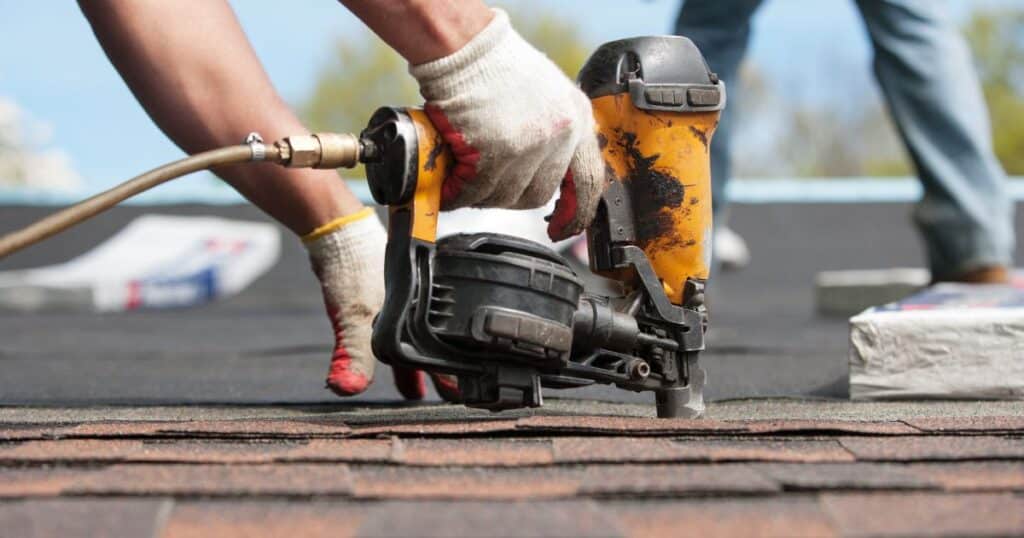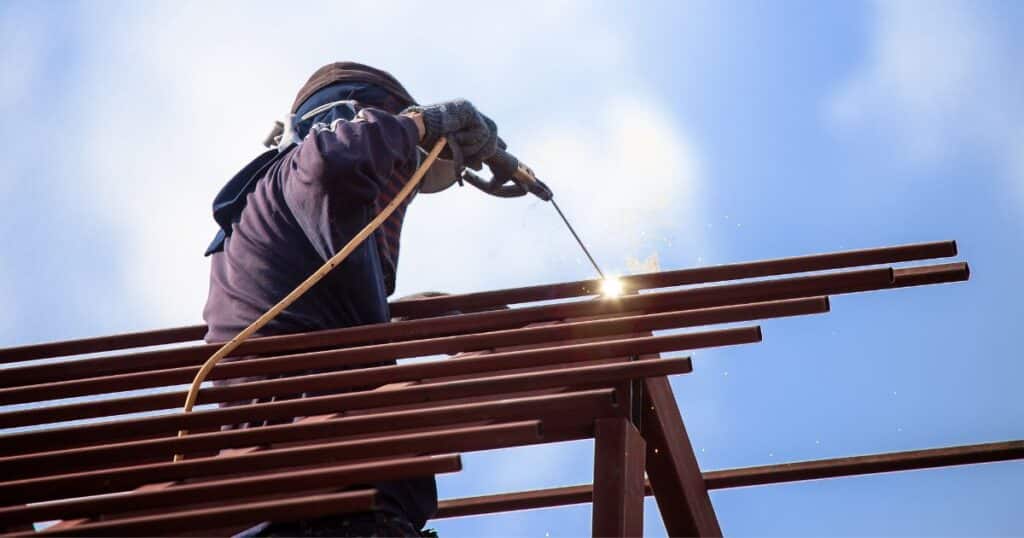
Choosing the right roofing material is crucial for homeowners, especially with rising temperatures caused by climate change. Reflective roofing materials can keep your home cool and save you money on energy bills, while also contributing to a more sustainable future. Avoiding materials that absorb heat, like traditional asphalt shingles, is key to maintaining comfort and reducing carbon emissions. What is the best roofing material to reflect heat?
The best roofing material to reflect heat is typically a light-colored or white roof. Materials like cool roof coatings, metal roofing with reflective finishes, or single-ply membranes with high solar reflectance are commonly used to achieve this. These materials help reduce heat absorption, keep the building cooler, and potentially lower energy costs for cooling.
The Top Roofing Materials for Heat Reflection
When it comes to choosing a roofing material that reflects heat effectively, there are several options available on the market today. Here are some of my top picks:
Metal Roofing
Metal roofing is an ideal option for those looking for an eco-friendly solution that is both durable and reflective. Unlike traditional asphalt shingles which absorb heat, metal roofs reflect it back into the atmosphere, keeping your home cooler and more comfortable during hot summer days.
Not only is metal roofing an excellent choice when considering its cooling benefits, but it’s also incredibly low maintenance compared to other materials such as wood or tile. In addition, metal roofing typically lasts much longer than other options – up to 50 years in some cases – making it an investment worth considering.
Tile Roofing
Tile roofing is another excellent option for those looking to reflect heat effectively. Traditional clay tile roofs are known for their ability to keep homes cool, and now modern materials such as concrete tiles offer the same benefits with added durability.
By choosing tile roofing, you’ll not only benefit from its cooling properties but also add an aesthetically pleasing element to your property. However, it’s worth noting that tile is a heavier material than others and may require additional structural reinforcement, adding extra costs to your installation.
Cool Roofs
Cool roofs are specially designed roofing systems that are coated with reflective materials to maximize heat reflection. These highly reflective surfaces can reduce roof temperatures by up to 50°F during the hottest summer days.
While cool roofs have many benefits in terms of heat reflection and energy savings, they do come with some drawbacks. The initial cost of installation can be higher compared to traditional roofing systems, and not all types of cool roofs are created equal – some work better in certain climates than others.
Choosing a roofing material that effectively reflects heat is essential for homeowners looking to save energy costs while preserving the environment. Whether you choose metal or tile roofing or opt for a specially designed cool roof system, taking the time to research your options can pay off in the long run both economically and environmentally.
RELATED: What is the Best Type of Roofing Material: Ascending to the Top
What is the Best Roofing Material to Reflect Heat?
Metal Roofing: Reflecting Heat in Style
When it comes to reflecting heat, metal roofing is the king of the hill. That’s right, folks – if you want to keep your home or business cool during the hottest months of the year, metal is the way to go. Not only is it incredibly durable and long-lasting, but it also boasts a high solar reflectance rating which means it absorbs less heat than other roofing materials.
But not all metal roofs are created equal. There are a variety of different types of metal roofing materials available on the market today, including aluminum, steel, copper, and zinc.
Each has its own unique benefits and drawbacks when it comes to reflecting heat effectively. Aluminum may be lightweight and affordable, but copper has a higher reflectivity rating which makes it ideal for warmer climates.
So how can you choose the best metal roofing material for your needs? It’s important to take into account factors like climate conditions in your area, your budget constraints, and even your home’s architectural style.
And while some may argue that metal roofs can be noisy during rain storms or even hail storms – I say bring on the rain! The sound of precipitation hitting my sturdy roof is music to my ears.
Tile Roofing: The Classic Solution with a Modern Twist
If you’re looking for an alternative solution that still provides outstanding heat reflection capabilities, tile roofing might be just what you need. Although they have been around since ancient times – with examples dating back as far as the 4th millennium BC – modern tile roofs offer both longevity and excellent insulation properties. But there are some downsides too – although they look great when first installed, over time, tiles can become brittle or cracked due to weather exposure which leads to leaks.
Tile roofs also tend to be heavy which means those wanting one must ensure the structure will support the weight. However, when it comes to reflecting heat effectively, tile roofs have got it down to a science.
Their natural insulation properties have earned them a reputation as one of the most effective roofing materials for keeping indoor spaces cool during warm weather. And with different types of tile materials available on the market today – from clay and concrete to ceramic and even slate – you’re sure to find one that suits your needs.
Cool Roofs: Stay Cool Without Sacrificing Style
Last but not least, we have cool roofs – an innovative solution to combating heat absorption while still looking stylish. What are cool roofs, you ask? Well, they’re made from materials that have been designed specifically to reflect sunlight and absorb less heat than traditional roofing materials.
But is it worth sacrificing style for energy efficiency? Absolutely not!
Cool roofs come in a variety of different colors and styles that can complement any architectural design. And while some may argue that they don’t provide quite as much heat reflection as metal or tile roofs – I say every little bit helps when it comes to saving energy costs.
When choosing the best cool roof for your home or building, there are several factors to consider, such as material type, color, and texture. But with benefits like reduced energy costs and increased comfort during hot summer months – who wouldn’t want one?
Niche Subtopics: Lesser-Known Options for Heat Reflection
Green Roofs: A Natural and Efficient Solution
Green roofs have been gaining popularity over the years and for a good reason. They are roofs that are partially or completely covered with vegetation, soil, and various layers of drainage and insulation materials. The benefits of green roofs are endless; not only do they reflect heat effectively by creating a natural cooling effect through evapotranspiration, but they also provide additional benefits such as insulation, noise reduction, and stormwater management.
In addition to being environmentally friendly, green roofs can help extend the life of your roof by protecting it from UV rays. Green roofs come in two main types: extensive and intensive.
Extensive green roofs require less maintenance as they feature shallow soil depths of 6 inches or less with drought-resistant plants like grasses or sedums. On the other hand, intensive green roofs require more maintenance as they have deeper soil depths of 6-12 inches or more with larger plants like shrubs or trees.
Solar Shingles: The Future is Bright
Solar shingles may sound like something out of science fiction movies, but they are becoming increasingly popular among homeowners who want to reduce their energy costs while also reflecting heat effectively. Solar shingles work just like solar panels but instead integrate into your roofing system so that they blend nicely with your home’s overall aesthetic appeal.
The best part about solar shingles is that they don’t require you to install traditional solar panels on top of your roof – reducing the overall weight load on your roofing structure while still providing clean energy. Along with reflecting heat well to keep your home cool in hot weather conditions, solar shingles can help you save money by offsetting some (or all) of your energy bills.
White Membrane Roofing: A Powerful Ally in the Fight Against Heat
White membrane roofing is a popular roofing material that reflects heat effectively by reflecting sunlight back into the atmosphere. These roofs feature single-ply membranes made from materials like PVC or TPO, which provide high reflectivity for greater energy efficiency.
Apart from reflecting heat and reducing your energy bills, white membrane roofing also offers other benefits, such as easy installation, durability, and resistance to weathering. They are also eco-friendly since they are often made from recycled materials and can be recycled themselves at the end of their useful lives.
RELATED: What is the Best Roofing Material for a Forge House?
Frequently Asked Questions
What roof material reflects the most heat?
The most heat-reflective roof materials include white or light-colored options such as white membrane roofs, metal roofs with reflective coatings, or clay and concrete tiles with light colors.
What material is best for roof cooling?
Materials with high reflectivity and emissivity, such as metal or tile roofs with reflective coatings or cool roof coatings, are best for roof cooling in hot climates.
What is the best roof for hot climate?
For hot climates, roofs with high solar reflectance and thermal emittance, such as metal roofs or white membrane roofs, are considered the best choices.
What is the most reflective roof?
White membrane roofs or metal roofs with reflective coatings are known for their high reflectivity and are considered the most reflective options for roofs.
What can I put on my roof to reduce heat?
To reduce heat on your roof, you can consider applying a cool roof coating or using reflective materials such as white membrane roofs or metal roofs with reflective coatings.
Which roof is cooling?
Cool roofs, such as those with high solar reflectance and thermal emittance, are designed specifically for cooling purposes and can help reduce heat on the roof.
Conclusion
Choosing the best roofing material to reflect heat is an important decision that can save you a ton of money on your energy bills while providing comfort during hot weather conditions. While traditional options like metal and tile roofs remain popular choices for homeowners looking to reduce their home’s temperature, lesser-known options like green roofs, solar shingles, and white membrane roofing offer unique benefits worth considering. So whether you’re looking for a natural solution or something more advanced, a roof out there will suit your needs perfectly.






